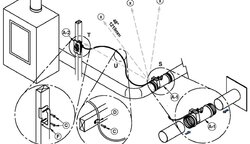Hi Folks,
Just thought I would introduce myself to the community - been cruising the forum for years but this will be my first post. Tons of great content on here so keep up the good work.
I've been having issues with absolutely nuclear secondary combustion in my PE Vista. This is a main floor install, story and half house, stove in centre of home and roughly 23-24' of chimney (all of which would be interior to the house - aside from 3-4' where it exits on roof).
I have ruled out stove leaks, replaced door/windows gaskets, sealed the ash dump and installed a damper about 24" up in the double wall connector. The damper helps, but no matter what, once I close down the primary, the secondaries will eventually go rogue as the draft increases and the stove warms up. This isn't a matter of me cutting the air too late - I can shut it down when the fire is burning quite poorly, with flue temps around 250 f, but the secondaries will eventually take over and go nuts. No lazy flames here, just the depths of hell roaring out of the baffles with flue temps into 600+...chews wood.
There is no secondary intake control/linkage off of the primary. I believe this design to be different than the Super or Summit stoves (correct me if I'm wrong). So the secondary is always wide open I guess, and once the primary is closed off, the secondary intake tube sucks air in hard which is causing the problem.
Any suggestions on what to do next? Cow magnets? Weld something up and create an adjustment for the secondary intake?
Thanks for any advice! Sorry for the novel.
Just thought I would introduce myself to the community - been cruising the forum for years but this will be my first post. Tons of great content on here so keep up the good work.
I've been having issues with absolutely nuclear secondary combustion in my PE Vista. This is a main floor install, story and half house, stove in centre of home and roughly 23-24' of chimney (all of which would be interior to the house - aside from 3-4' where it exits on roof).
I have ruled out stove leaks, replaced door/windows gaskets, sealed the ash dump and installed a damper about 24" up in the double wall connector. The damper helps, but no matter what, once I close down the primary, the secondaries will eventually go rogue as the draft increases and the stove warms up. This isn't a matter of me cutting the air too late - I can shut it down when the fire is burning quite poorly, with flue temps around 250 f, but the secondaries will eventually take over and go nuts. No lazy flames here, just the depths of hell roaring out of the baffles with flue temps into 600+...chews wood.
There is no secondary intake control/linkage off of the primary. I believe this design to be different than the Super or Summit stoves (correct me if I'm wrong). So the secondary is always wide open I guess, and once the primary is closed off, the secondary intake tube sucks air in hard which is causing the problem.
Any suggestions on what to do next? Cow magnets? Weld something up and create an adjustment for the secondary intake?
Thanks for any advice! Sorry for the novel.



 Maybe someone needs to make a tighter damper. OAK with a ball valve on the intake side??? I was thinking about that but the damper got me what I needed.
Maybe someone needs to make a tighter damper. OAK with a ball valve on the intake side??? I was thinking about that but the damper got me what I needed.